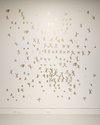John Hurrell – 1 March, 2019
With her mural and framed wall works Frankovich has analysed bodily fluids within her own body (a mural that looks at the artist's chromosomes, much like Billy Apple's perpetuity project). With these projects, Frankovich shows she is preoccupied with mingling biological communities—like Sorawit Songsataya—that imply multiple selves co-existing as groups, each a collection of ‘social bodies' driven by a single mind.
As in the Richard Frater show down the road at Lett’s, this new Alicia Frankovich show is very much about ecosystems and mini-universes that occur in fluids. And it is self-titled for good reason.
In her video that examines the genomic properties of kefir, the probiotic drink made from fermented milk, these fluids are globally or cosmically all-encompassing—looking like the deepest sea or outer space—but with her mural and framed wall works Frankovich has analysed bodily fluids within her own body (a mural that looks at the artist’s chromosomes, much like Billy Apple’s perpetuity project).
With these projects, Frankovich shows she is preoccupied with mingling biological communities—like Sorawit Songsataya‘s —that implies multiple selves co-existing as groups, each a collection of ‘social bodies’ driven by a single mind.
On the wall or in works on paper, Frankovich presents scattered chromosomic pictographs that allude to cave paintings (they could be made with two smearing fingers), despite being grounded in genetic blood analysis—pairs of wiggling ‘worms’ hovering and twitching in clear fluid.
Most pairs of lines are gold, but occasionally, some are pink. This seems to imply other selves are living inside us of which we are largely unaware. Many DNA communities coexist side by side within ‘our own’ cellular structures, other bodies sharing ‘individual’ metabolic genetic information with ‘us’.
Here Frankovich is attacking the corporeal sanctity of the individual Self. Embracing a plurality of minds in the sense of Walt Whitman‘s “I contain multitudes” is now common, but claiming that different genetic communities bodily dwell within us is clearly unusual. Like the notion that there is no such thing as solid matter, only very rapidly moving atomic particles, it says that our membranous bodily outer limits are permeable—not nonporous boundaries—and that we are inhabited by components of other physical Selves. It points to osmotic processes we’re not fully aware of—and that the conventional western view of the Self and personal identity is obsolete.
John Hurrell


 Advertising in this column
Advertising in this column Two Rooms presents a program of residencies and projects
Two Rooms presents a program of residencies and projects



This Discussion has 0 comments.
Comment
Participate
Register to Participate.
Sign in
Sign in to an existing account.